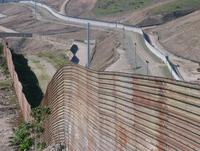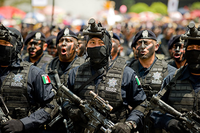-
Problems-plagued border sensor program put on hold by CBP
Two years ago, DHS cancelled SBInet, the ambitious Bush-era project to install advanced sensing technology along the border. The project was cancelled after more than $1 billion were spent on a few towers equipped with sensors which were built along a 28-mile stretch and the Arizona-Mexico border. Now CBP has put on hold one of SBInet’s successors, a project aiming to install sophisticated ground sensors along the U.S.-Mexico border.
-
-
Gang of Eight: DHS secretary to determine if border is secure

Even supporters of immigration reform admit that security along the U.S.-Mexico border should be improved so that legalizing the status of the eleven million undocumented immigrants currently in the United States would not become a magnet for drawing even more undocumented immigrants into the country. How do we know, however, whether the border is secure enough for the legalizing process to begin? A bipartisan group of senators, known as the Gang of Eight, has an idea: under the terms of the bipartisan framework for immigration reform, DHS secretary Janet Napolitano would make the final determination about whether or not the border is secure. Once she makes the determination that the border is secure, the eleven million undocumented immigrants would start on their path to a legal status in the country.
-
-
DHS secretary says El Paso border is secure

During a visit to El Paso, Texas on Tuesday, DHS secretary Janet Napolitano highlighted improvements in border security, as many in Congress argue that the path to immigration reform begins with making sure the U.S.-Mexico border is secure.
-
-
Why some immigrants get citizenship

For immigrants, the path to citizenship in many countries is filled with hurdles: finding a job, learning the language, passing exams. For some people, however, the biggest obstacle of all may be one they cannot help: their country of origin.
-
-
Mexican officials hope for real changes in U.S. gun policy

The majority of the guns used in drug-related violence in Mexico have come from the United States. Numbers from the Bureau of Alcohol, Tobacco Firearms and Explosives show that almost 70 percent of the 99,000 weapons seized in Mexico in 2012 came from the United States. Mexican officials are hoping that president Obama’s speeches on changing the U.S. gun policy will be more than just talk.
-
-
Controversial full-body scanners at U.S. airports to be replaced
The controversial full-body airport scanners which upset many passengers because of the anatomically accurate images they produced, will be removed from U.S. airports by June, according to the Transportation Security Administration(TSA), ending a $40 million contract with Rapiscan Systems, the manufacturer of the scanners. Rapiscan’s backscatter X-ray scanners are being replaced by less intrusive millimeter wave scanners.
-
-
Ariz. Governor Brewer offers a softer approach to illegal immigration
Arizona governor Jan Brewer has made a name for herself for always taken a her hard line stance on the subject of illegal immigration, but recently she has begun to soften her tone on the issue. While Brewer’s position has not changed — she prefers border security over immigration reform — her tone has, as the State of the State address last week suggests.
-
-
Advocates of immigration reform eye Canada’s guest worker program as a model
When many Mexicans head north for seasonal work, they no longer have to smuggle their way through the U.S.–Mexican border; now they can hop a fight to Canada; in a government-to-government deal between Mexico and Canada, almost 16,000 temporary Mexican workers are able to earn good wages in Canada as part of a guest worker program; as discussions about immigration reform in the United States continue, some eye the Canadian guest worker program as a model to be emulated
-
-
New Mexican government to set up a new police force to fight drugs, crime

Mexican president Enrique Pena Nieto has said his government would create a new national police force as part of a new approach to dealing with drugs, crime, and violence; Pena Nieto took office on 1 December; the new, militarized police force would have about 10,000 officers initially, but would eventually grow to 40,000
-
-
Detecting tunnels -- used to smuggle drugs, weapons, or people – is not easy
It seems reasonable to assume that it would be easy to use seismic waves to find tunnels dug by smugglers of drugs, weapons, or people, but this assumption is wrong; scientists are trying to get a better look at the ground around tunnels to learn why seismic data finds some tunnels but not others – and come up with a seismic detection process for the border and other areas where tunnels pose a security threat
-
-
Face-recognition e-Gate at Amsterdam airport moving passengers at rapid pace
E-Gate, the automated border control system developed by Accenture and Vision-Box for the Netherlands Ministry of Internal Affairs, is on target to process its one-millionth passenger at Schiphol Airport in December
-
-
DHS finally investigates Border Patrol policies on deadly force

It was reported last week that DHS’s Office of the Inspector General was investigating charges of excessive force by Border Patrol guards at the Mexican border; to change the dysfunctional culture prevalent among some Border Patrol agents in certain border stations, however, will require much more than an investigation by DHS IG of policies regarding the use of deadly force; what is required at a bare minimum is more, not less, professional training at the national academy, a legitimate mentorship program for all new agents by experienced mentors, legitimate agency support for continued professional development of agents, promotions based on merit rather than paternalistic decision-making, and a number of other reforms neither DHS nor the CBP are willing to acknowledge
-
-
Border Patrol relies in obsolescent surveillance gear
An Obama administration plan to update equipment the Border Patrol is using did not materialize, and now officials are concerned about outdated equipment putting the lives of agents in danger; the sensors now in use were originally said to be able to put Border Patrol agents in position to capture 90 percent of border invaders, but the DHS inspector general determined that just 4 percent of the alarms were confirmed cases of smugglers and border crossers; 34 percent were false alarms, and 62 percent were undetermined
-
-
To ensure success, Mexican drug cartels emulate corporate business model
When the subject of Mexican drug cartels come up, most people think of bloody violence, pounds of cocaine or marijuana, and so much money people have to weight it instead of counting it; what people do not think about is the business models the cartels emulate – and they emulate the models and management charts of typical American corporations
-
-
Sharp drop in illegal crossers notwithstanding, “border industrial complex” keeps growing
Since 1986, U.S. immigration enforcement has cost the U.S. government $219 billion dollars; almost 80,000 workers now depend on immigration enforcement for their employment; illegal immigration has dropped sharply over the last four years, and is now at a 1971 level — but the what some call the “border industrial complex” keeps growing and growing
-
- All
- Regional
- Water
- Biometrics
- Borders/Immig
- Business
- Cybersecurity
- Detection
- Disasters
- Government
- Infrastructure
- International
- Public health
- Public Safety
- Communication interoperabillity
- Emergency services
- Emergency medical services
- Fire
- First response
- IEDs
- Law Enforcement
- Law Enforcement Technology
- Military technology
- Nonlethal weapons
- Nuclear weapons
- Personal protection equipment
- Police
- Notification /alert systems
- Situational awareness
- Weapons systems
- Sci-Tech
- Sector Reports
- Surveillance
- Transportation
Advertising & Marketing: advertise@newswirepubs.com
Editorial: editor@newswirepubs.com
General: info@newswirepubs.com
2010-2011 © News Wire Publications, LLC News Wire Publications, LLC
220 Old Country Road | Suite 200 | Mineola | New York | 11501
Permissions and Policies
Editorial: editor@newswirepubs.com
General: info@newswirepubs.com
2010-2011 © News Wire Publications, LLC News Wire Publications, LLC
220 Old Country Road | Suite 200 | Mineola | New York | 11501
Permissions and Policies
